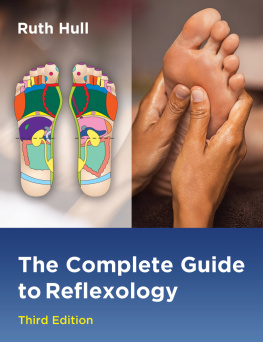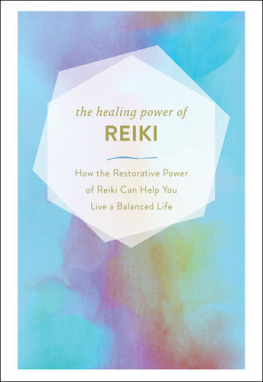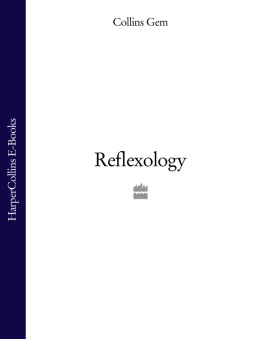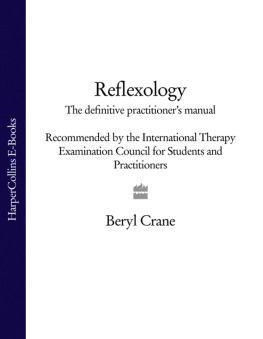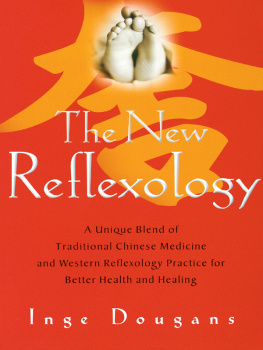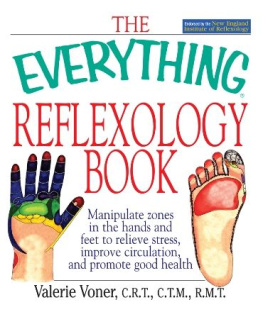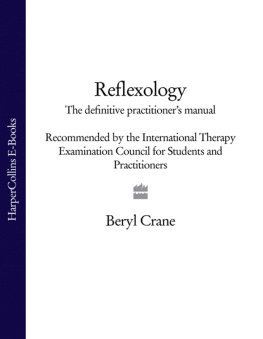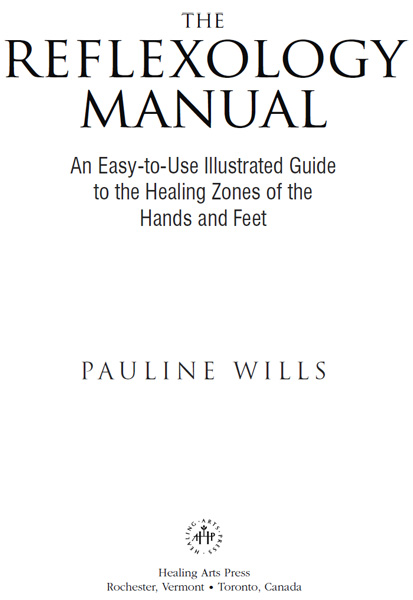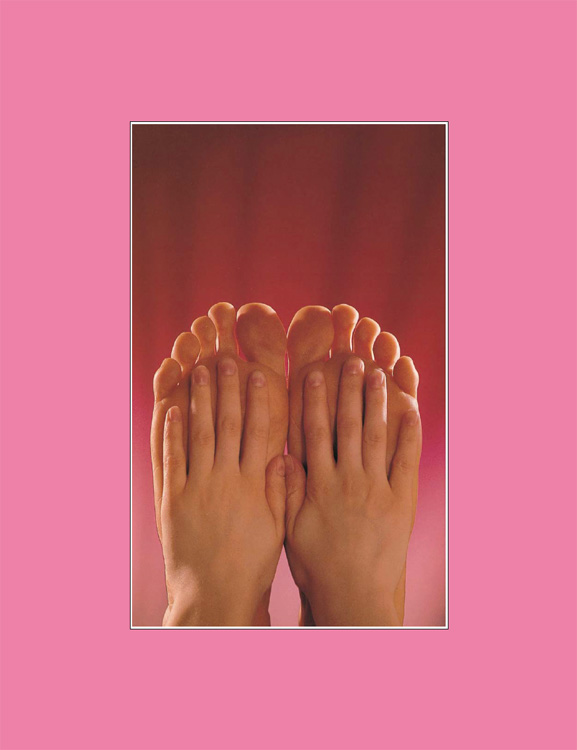The author wishes to acknowledge Jacqueline Palmer, Cecilia Walters, Patricia Jackson, Zo Hughes, Elaine Partington and all others who have worked so hard to bring this book to publication.
The photograph on (The history of reflexology) is reproduced by kind permission of Werner Forman Archive. The photograph on (Treatment with colour) is reproduced courtesy of Zefa Pictures Ltd.
What is reflexology?

O riginally known as reflex zone therapy, reflexology is a holistic healing method which involves pressure and massage of the reflex points found on the feet and hands. The dictionary defines the word reflex as an involuntary muscle contraction due to an external stimulus. In the context of reflexology, however, reflex is used in the sense of reflection, or mirror image. These reflexes are found on the soles of the feet, or the palms of the hands, which act as small mirrors reflecting the whole organism.
Reflexology teaches that a vital energy, or life force, circulates between the organs of the body, permeating every living cell and tissue. If this energy becomes blocked, the part of the body relating to the blockage is affected. Energy blocks in the human body are reflected on the hands and feet in one or more of the zones located there. By using specific pressure techniques, they can be detected through the experience of pain, or through the presence of gritty areas, often referred to as crystal deposits. These occur in the part of the foot or hand that relates to the part of the body that is imbalanced. The pressure and massage techniques taught in reflexology are designed to dissipate energy blocks, and break down crystalline structure. Through stimulation of the circulatory and lymphatic systems, and by encouraging the release of toxins, reflexology promotes the body to heal itself.
Apart from treating disease, reflexology is an extremely effective therapy in cases of stress, tension and tiredness. And, like acupuncture, it can also be used as a preventive measure against ill health.
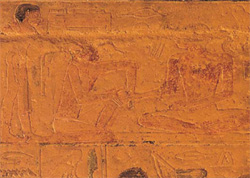
Above Hand massage. Detail from a relief on Ankhamors tomb at Saqqara, Egypt.
The history of reflexology

T he origin of reflexology, or zone therapy as it was called, still remains a mystery. In his book, Zone Therapy, Dr William Fitzgerald states that a form of treatment by means of pressure points was known in India and China 5,000 years ago. This knowledge, however, appears to be lost or forgotten. Perhaps it was set aside in favour of acupuncture, which emerged as the stronger growth from the same root. Another conjecture is that it began in Egypt. Evidence for this stems from an Egyptian tomb drawing dating back to 2330 BC This drawing depicts four people; one person is being treated with foot massage and a second person with hand massage. Others credit its birth to the Incas, a people who belonged to a very ancient Peruvian civilization, possibly reaching back to 12,000 BC. It is speculated that they passed down their knowledge of zone therapy to the North American Indians who are still using this form of treatment today.
What is certain is that zone therapy was being used as far back as AD 1500. Cellini (15001571), the great Florentine sculptor, is reported to have used strong pressure on his fingers and toes in order to relieve pain in his body with apparent success. The American president, James Abram Garfield (183181), who was the victim of an assassination attempt, is said to have alleviated the resulting pain by applying pressure to certain points on his feet. During the sixteenth century, several books on zone therapy were published in Europe. One of these was written by Dr Adamus and Dr Atatis. Shortly after it appeared on the market, a similar book was published by Dr Ball in Leipzig.
The credit for initiating reflexology as it is known today must be given to Dr William Fitzgerald. Born in 1872, he graduated in medicine at the University of Vermont, USA, in 1895. After practising in hospitals in Vienna, Paris and London, he became an ear, nose and throat specialist and settled in Connecticut. While working in Vienna, he studied the work of Dr H. Bresslar, who had researched the link between pressure points on the feet and the internal organs of the body and published his findings in a book, Zone Therapy. Interestingly, Dr Bresslar mentions that therapeutic foot massage was practised during the fourteenth century.
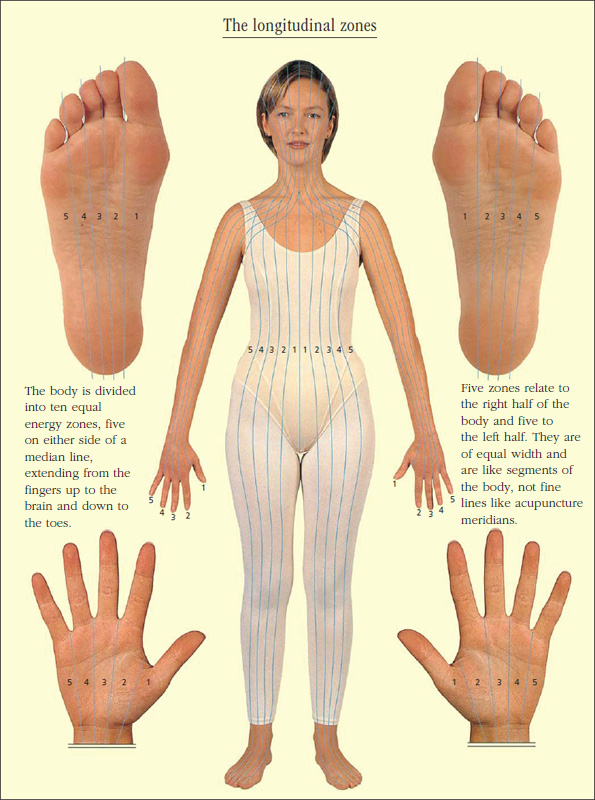
Dr Fitzgerald started to practise zone therapy techniques on his patients. To apply pressure, he used rubber bands, clamps and probes. He discovered that pressure applied to some parts of the foot induced anaesthesia in specific parts of the body. His continuing research led him to formulate the division of the body into ten equal longitudinal energy zones five relating to the right half of the body and five to the left half by drawing an imaginary line from the top of the head down through the centre of the body.
These ten energy zones terminate on the soles of the feet and the palms of the hands. Zone one incorporates the thumb, extends up the arm into the shoulders and neck to the brain, and then down the body to the big toe. Zone two extends from the index finger, up the arm into the shoulders, neck and brain and down the body to the second toe. The third zone extends from the middle finger, up the arm to the shoulder, neck and brain, then down the body to the third toe. The fourth zone begins with the ring finger, travelling up the arm into the shoulder, neck and brain, then down the body to the fourth toe. The fifth zone extends from the little finger, travelling up the arm to the shoulder, neck and brain and down the body to the fifth toe.
In 1916 Dr Edwin Bowers, Dr Fitzgeralds colleague, publicly described the treatment propounded by Dr Fitzgerald, referring to it as zone therapy. A year later their combined work appeared in a book entitled Zone Therapy. It contained treatment suggestions and recommendations for doctors, dentists, gynaecologists, ear, nose and throat specialists and chiropractors. The first edition included diagrams of the reflexes of the feet and the corresponding ten zones of the body. Dr Fitzgerald soon began to give courses on this method of treatment to medical practitioners.


